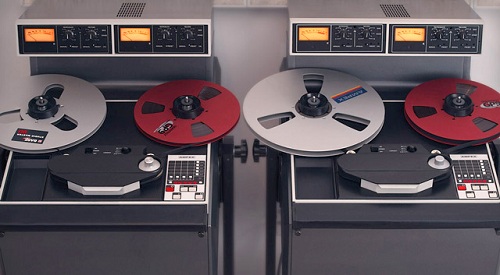Ampex ATR-100 Master Recorder/Reproducer
Message Board - AMPEX ATR-100 General Discussion
The Ampex ATR-100 is a multitrack tape recorder, designed by Ampex Corporation, of Redwood City, California. It was introduced at the Spring 1976 AES Conference in Los Angeles, and was geared towards the ultra high end studio market, and having been designed specifically as a stereo or quadrophonic (2 or 4 track) mixdown and mastering deck. It has gained a virtually unchallenged reputation in the recording industry and amongst engineers as the most accurate tape recorder ever to be produced.
The ATR-100 series Recorder/Reproducers are professional quality audio tape recorder/reproducers that use 1/4-lnch (6.44 mm) or 1/2-inch (12.7 mm) wide magnetic tape on EIA or NAB reels up to 14 inches {35.56 cm) in diameter. The recorder/reproducer can operate in either the NAB or IEC equalization standard at any two speeds selected from the following speeds; 3.75, 7.5, 15, and 30 in/s (9.5.19.05,38.1 and 76 cm/s).
A plug in-type head assembly permits easy conversion between one and two-channel operation using 1/4-inch tape, or four-channel operation using 1/2-inch tape. The system is available in five different mounting configurations: cabinet, cabinet mounted on a roll around pedestal, fixed-rock mount, slide-rack mount, and portable case.
The recorder/reproducer does not incorporate a capstan pinch roller but controls tape movement in all modes of operation while under capstan and reel servo control. The capstan servo controls speed and direction while the reel servo maintains dynamically constant tape tension in all modes of operation.
The basic system incorporates such standard features as an electronic tape timer, Sel-Sync*, PURC (Pick-up Recording Capability), dynamic braking, ceramic tape guides, and ferrite heads. The tape timer displays in hours, minutes and seconds (or minutes, seconds, and tenths of seconds by changing a jumper) the distance the tape has moved from a zero reference point. The Sel-Sync feature permits the recording of added channels in perfect synchronization with previously recorded channels. The PURC feature eliminates the problem of overlaps and holes in recordings when inserting (dubbing) new material within previously recorded programs. The system does not have mechanical brakes, but incorporates dynamic braking to control all reel braking functions including stopping tape motion when power is removed.
The basic recorder system consists of a tape transport, head assembly, control unit, electronics assembly, and power supply assembly.
Foundational text courtesy of AMPEX and Wikipedia.

Ampex ATR-100 1/4" and 1/2" Master Recorders/Reproducers - Fully restored by John Chester and Steve Puntolillo of Sonicraft A2DX Lab - Photo courtesy of Steve Puntolillo
Ampex ATR-100 Tape Machine
Do you have content, to add, about the Ampex ATR-100 Tape Machine or associated topics? Please feel free to Share it, here!
What other Visitors have said about the Ampex ATR-100 Tape Machine
Click below to see contributions from other visitors to this page...
ATR-100 half inch - utterly brilliant Not rated yet
We had four of these at Townhouse Studios, London. I remember them performing with literally NO repairs in the two years I was there. Absolutely the best …
Return from Ampex ATR-100 Tape Machine to Magnetic Tape Recorders and Reproducers
Return from Ampex ATR-100 Tape Machine to History of Recording - Homepage |


